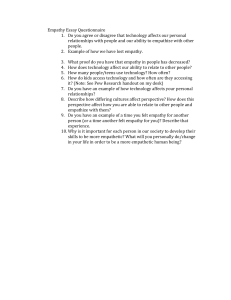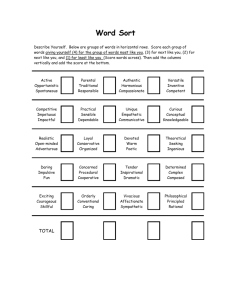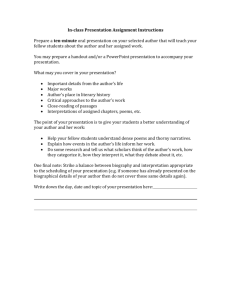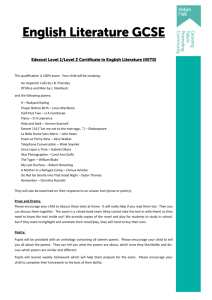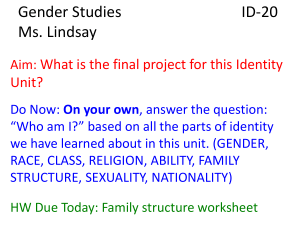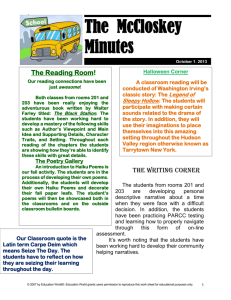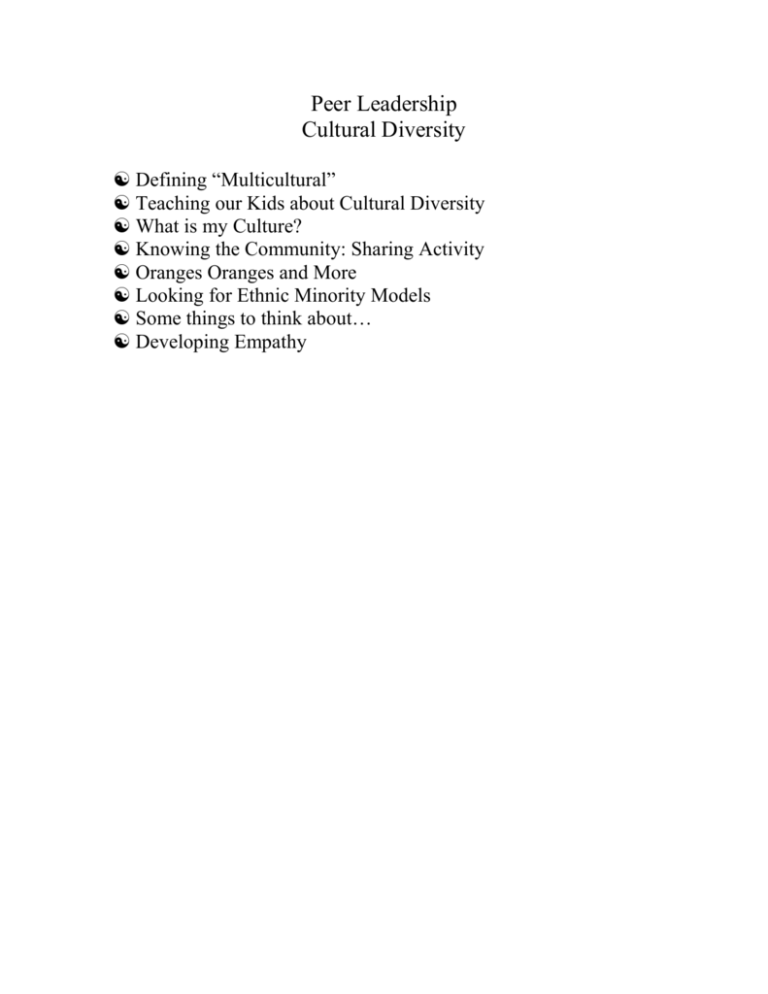
Peer Leadership
Cultural Diversity
Defining “Multicultural”
Teaching our Kids about Cultural Diversity
What is my Culture?
Knowing the Community: Sharing Activity
Oranges Oranges and More
Looking for Ethnic Minority Models
Some things to think about…
Developing Empathy
Multicultural – of, pertaining to, or representing several different cultures or cultural elements:
a multicultural society.
a. The totality of socially transmitted behavior patterns, arts, beliefs, institutions,
and all other products of human work and thought.
b. These patterns, traits, and products considered as the expression of a particular
period, class, community, or population: Edwardian culture; Japanese culture;
the culture of poverty.
c. These patterns, traits, and products considered with respect to a particular
category, such as a field, subject, or mode of expression: religious culture in the
Middle Ages; musical culture; oral culture.
d. The predominating attitudes and behavior that characterize the functioning of a
group or organization.
Where do you get information about individuals and groups related to race, gender,
socioeconomic class, and other social or cultural identities?
When you meet somebody new, how do you attempt to understand that person? Is the way
you attempt to understand someone else consistent with how you, yourself, wish to be
viewed?
Mentality needed to teach/encourage cultural awareness:
1) Know yourself –Ask yourself - what are my beliefs/ ideas about cultural diversity and
tolerance?
2) Be open …. Enough to recognize and deal with our prejudices
*The best way to teach others about cultural diversity is to let them see that you are accepting
and tolerant.
*We all look different on the outside … different colors of hair, eyes, and skin. We all believe
differently about a lot of different things. We all have personal burdens to bear ….. Recognizing
these differences and using them to hurt someone is NEVER acceptable (for the victim or
offender).
Teaching Our Kids about
Cultural Diversity
http://www.more4kids.info/589/teaching-kids-cultural-diversity/
by Jennifer Shakeel
There is no denying the fact that our children
today are faced with more diversity then we
parents were at their age. America is the “melting
pot” of the world and that is a good characteristic.
It is here in America you can experience the
different cultures of the world without leaving this country and for many with
out leaving their state or city. All of the diversity raises a very good question
though, how as parents we teach our children about cultural diversity and
tolerance.
First, in order to teach our children about cultural diversity and tolerance, we
as parents need to figure out what our beliefs are about those two topics.
How open are we to people from another culture or race. Knowing if we have
any biases or prejudices against people that are different. Knowing if we do,
admitting that we do and then figuring out why we have those beliefs is the
first step. The goal is teach our children about the different cultures and
introduce them to the different way people live and why. We do not want to
cloud their judgment and give them biases.
As adults, it can be hard to open ourselves up enough to recognize and deal
with our prejudices, but it is something we need to do for our children’s’
sake. You want your child to be open to new experiences and new people. In
order for them to be that way, you need to be that way. Read books with
your children about other cultures. Many libraries have wonderful selections
about different cultures and societies from around the world. Talk to your
local librarian and check out a few books and read them with your child.
Make sure that they are age appropriate and if your child has more
questions, the two of you can use the internet together to get answers.
Where we live, the schools have done a really nice job about bringing out
the different cultures that are present among the students in the school.
They all do reports about different cultures where they have to do the
research, write a report and create something from that culture to share
with the class. They also do a “Cultural Awareness” night at school. For this,
families are asked to set up a booth in the gym with posters, and maps and
traditional clothing and present something about their culture to the people
that come through the “fair.” Thankfully, many families participate and there
is food and music and dances and art and toys from all over the world right
there in the gym.
That is something that the kids really look forward to and we enjoy doing
with them. We participate in the fair, our family has a nice cultural mix. I am
from America and my husband is from Pakistan. We were both raised very
differently but have come together and created a wonderful harmony that
has allowed our children to experience many things that most of their friends
haven’t. They have friends from different cultures and we all get together
and have dinners and celebrate different events together.
We decided as parents that we would educate our children about the
different religions and spiritualities and when they were ready, they could
make the decision about what they believed in. We do not eat pork, we do
celebrate the holidays, and we honor diversity and celebrate the fact that we
are our own culture. We do this because kids are smarter then many adults
give them credit for. When we talk to our children about where we have
come from, or about other people that we know and that they are friends
with we talk to them intelligently. If we don’t have an answer for a certain
question we tell them that we do not know and then we find the answer
together.
The best way to teach your child about cultural diversity is to let them see
you are accepting and tolerant. Our children emulate us, they act the way
they do because of what they see their parents do. If you are open to other
people, and make an effort to learn more about the different cultures, your
child will eagerly want to do the same.
Make an effort to get to know your neighbor. Have dinner with a family that
is different than your own. Encourage your child to make friends with other
children. Ask them about the other kids on their class. We taught our
children that they need to look at each person as a person.
We all look different on the outside, different colors of hair, eyes and skin.
We all believe differently about a lot of different things. Pointing out those
differences and uses those differences as reasons to not talk to someone is
never acceptable. We have also told them that it is never okay for another
person to something to them that makes them feel bad or hurts them or
others.
Tolerance means understanding and openness, it does not mean acceptance
of cruel behavior. That goes for everyone regardless of their culture.
Biography
Jennifer Shakeel is a writer and former nurse. As a mother of two incredible
children, I am here to share with you what I have learned about parenting.
One of my children has ADD, our journey of learning to come to terms with
the diagnosis and figuring out what works best for us has been a challenge
and a joy. Our son was diagnosed about two and half years ago, and we
have had our ups and downs, joys and sorrows. If I can just offer you one
day of hope or one idea that may work to help you and your family then I
know that my purpose has been fulfilled.
No part of this article may be copied or reproduced in any form
without the express permission of More4Kids Inc © 2007 All Rights
Reserved
Knowing the Community: Sharing Activity (Introductory-Level)
Objectives:
(1) Participants will learn the names of each person in the class, group, or community, as well as
something about each person's background.
(2) Participants will have a greater understanding and appreciation for the diversity within the group, while
realizing that they have things in common with some of the people from whom they might have felt most
distant.
Activity Description:
Participants should sit in a circle for this exercise if possible. The facilitator should hand out a list of items
for each participant to share with the group. Items could include name/nicknames, ethnic background,
where they are from and where their parents were born, which generation they represent in the U.S. for
their family, and one custom or tradition their family practices. Give participants time to record some of
their initial thoughts on these items.
Before you begin the exercise, instruct the participants to identify one or two people in the group who they
do not know and to think about what answers they expect from those people. This part is not to be shared
among group members, but can help people realize how they formulate ideas about people based on
appearance.
Now you are ready to begin. It is important to tell the group that each person will be limited to about two
minutes in order for everyone's voice to be heard. Once everyone has had an oppurtunity to share their
information, ask the group to discuss what they have learned from the exercise.
Facilitator Notes:
(1) I would suggest that the facilitator begin this exercise in order to model the kind of information that
should be shared.
(2) This activity can be emotional for certain people. The participants who find this emotional are often
those who don't know a lot about their heritage, including those who been adopted. If someone seems to
be getting emotional remind them that they only have to reveal what they feel comfortable revealing. If
this doesn't come up organically in the conversation, raise it as an example of "privilege"--that the ability
to trace one's ancestry is an example of privilege and the inability to do so often is a reflection of
repression, oppression, or more systemically, imperialism.
(3) Certain themes usually emerge:
Even members of the same identity "groups" have very different backgrounds.
Often members of different "groups" have more similar backgrounds than they had assumed.
Diversity transcends "black and white."
Many people find out information which allows them to connect somehow with someone else in
the group. (Last year, a member of a group I facilitated revealed that her mother's maiden name
was "Gorski" which is my last name. We're still exploring the possibility that we're related.)
(4) Ask participants why this is an important activity.
Who I Am Poems (Introductory-Level)
Preparing and Assigning:
This activity begins an active introspective process while continuing to provide opportunities for individuals to make connections with
each other. Participants write short poems, starting each line with "I am," encouraging them to describe in their own words who they
are and what's salient to their identities.
Objectives:
In any attempt to increase awareness and encourage self-development, it is crucial to engage participants in activities that call for
introspection and self-reflection. It is also important to provide opportunities for participants to make connections across, and even
within, identity borders. The "Who I Am" activity can provide a non-threatening starting point for encouraging self-reflective thought
and introspection. It is a safe way for participants to think about and share the influences that have shaped their identities. Also, it
continues the connection-making process as participants find unexpected similarities and differences between themselves and others
in the group.
This activity also can be an excellent closing activity, allowing folks to re-connect at a self-defined and human level at the end of an
experience in which they are discussing difficult issues.
Instructions:
Ask participants to take ten to fifteen minutes to write a poem called "Who I Am." Instruct them that the only rule is that each line
should begin with the words "I am..." Leave it open to their interpretation as much as possible, but suggest that they can, if they wish,
include statements about where they're from regionally, ethnically, religiously, and so on; memories from different points in their lives;
interests and hobbies; mottos or credos; favorite phrases; family traditions and customs; and whatever else defines who they are. Be
sure to let them know that they will be sharing their poems.
Facilitator Notes:
In order to ensure that everybody has an opportunity to share her or his story, you might consider breaking the group into diverse
small groups of 8-10 if necessary. Give participants the option either to read their poems or to share parts of their poems from
memory.
Points to remember:
1. Because some individuals will include very personal information, some may be hesitant to read their poems, even in small
groups. It is sometimes effective in such situations for facilitators to share their poems first. Consider sharing your poem
before asking students to write their own pieces. If you make yourself vulnerable, others will be more comfortable doing the
same.
2. Be sure to allow time for everyone to be able to speak, whether reading their poems or sharing them from memory.
3. If you're using this as a final activity, not much processing is necessary. Encourage applause and thank folks for sharing their
poetry.
4. If you use this activity in the middle of a class or workshop, have some process questions ready. When everyone has shared,
ask participants how it felt to share their poems.
5. Ask what, if any, connections people made with each other from this activity. What were some commonalities across poems?
Did any of these surprise you?
6. You might also consider asking people to get up and talk to someone with whom she or he felt a connection through the
poetry.
Sample - My Personal "I Am From" Poem:
I am basketball on a snowy driveway.
I am fishsticks, crinkle-cut frozen french fries and frozen mixed vegatables.
I am primarily white, upper-middle class neighborhoods and raciall diverse schools.
I am Donkey Kong, Ms. Pac Man, Atari 2600 and sports video games.
I am football on Thanksgiving and New Year's Day.
I am "unity in diversity" and "speaking from your own experience."
I am triple-Wahoos, earning three degrees from the University of Virginia.
I am diversity, multicultural education, identity, introspection, self-reflection, and social action.
I am Daffy Duck, Mr. Magoo, Hong Kong Phooey, Foghorn Leghorn, and other cartoons.
I am Tae Kwon Do, basketball, the batting cages, a soccer family, and the gym.
I am a wonderful family, close and loving and incredibly supportive.
I am films based on true stories and documentaries
I am the History Channel, CNN, ESPN, BRAVO, and Home Team Sports.
I am a passion for educating and facilitating, personal development and making connections.
Oranges, Oranges and More
It is not uncommon or surprising to see students wonder what they can
learn from a piece of fruit, such as an orange. An orange can open many
windows to understanding and teaching cultural diversity. In this activity,
students are separated into groups and given one orange per group.
Students are instructed to examine and become familiar with their orange.
Students may not mark on their orange. All groups put their orange in a bag
provided by the instructor. A representative from each group then identifies
their group's particular orange. Students learn that even though oranges
appear to be similar or undistinguishable, upon further examination they can
identify differences. Ultimately the students make the connection between
diversity in oranges and diversity in humans.
Activity
Looking for Ethnic Minority Models
Objective:
Examine the use of ethnic minority models in magazines
Activity Materials List:
Collection of magazines
Activity:
Magazines seldom reflect the diversity of our culture. When images are
reproduced by the millions, they can appear to represent the “norm.” But
our culture isn’t as exclusive as these images. Beauties that grace the covers
of magazines may be predominantly thin, pale, and blond, but we know that
real life beauties come in all shapes, and all colors.
Have your students skim through several magazines and look for Asian
American, Latina/Latino, Native American and African American models. Ask
them to keep track of whom they find in most ads, and which groups are
rarely seen. Discuss the findings as a class.
Some things to think about …
You’ve got to be taught to hate and fear,
You’ve got to be taught from year to year,
It’s got to be drummed in your dear little ear.
You’ve got to be carefully taught.
You’ve got to be taught to be afraid
Of people whose eyes are oddly made
And people whose skin is a diff’rent shade
You’ve got to be taught before it’s too late,
Before you are six or seven or eight,
To hate all the people your relatives hate.
You’ve got to be carefully taught.
You’ve got to be carefully taught.
~Oscar Hammerstein II, 1949
“Racism always involves an injustice committed by one person or one group against another
person or group for reasons of race, color, religion or political ideology. It is fatal in the end
because it always works to damage both groups. “ ~ John Howard Griffin, 1977
“Surely few crimes are more tragic than the crime of fostering in children a false view of what
man is by teaching them to believe that any other humans are basically different in their human
needs or in their response to the frustration of those needs. This concept of fellow human beings
as “other” is at the base of all racism.” ~John Howard Griffin, 1997
“A young child … asks his mother why the man in the store is so dark. Instead of answering, his
mother tells him to be quiet, which tells the child it’s not okay to discuss differences. “ ~ Beverly
Daniel Tatum, 1998
“Our children must be taught that racial peculiarities do exist, but that beneath the skin, beyond
the differing features and into the true heart of being, fundamentally, we are more alike, my
friends, then we are unalike.” ~Maya Angelou, 1993
“Sometimes change comes not in the first round, but at the second, third, or forth. Change starts
with one person questioning, challenging, speaking up and doing something to make a
difference. We can each make a difference …” ~Paul Kivel, 1993
Thoughts taken from “And don’t call me a racist!” A treasury of quotes on the past, present, and
future of the color line in America. Selected and arranged by Ella Mazel
Developing Empathy: High School
http://www.tolerance.org/supplement/developing-empathy-high-school
Objectives: Activities will help students:
understand empathy
practice ways to be more understanding
reflect on the effects of empathetic listening
Essential Questions
What does it mean to put yourself in someone else’s shoes?
How empathetic am I?
How can I better show empathy toward others?
Activities
1.
2.
3.
4.
5.
6.
7.
Can you think of a time—maybe during an argument with a friend or when the boy or girl you
liked hurt your feelings—when you wished that someone understood how you felt? When we try
to relate to what another person is going through, we’re being empathetic.
Do you think you’re an empathetic person? Respond to each statement on Are You Empathetic?
with “yes” if it describes something you do or “no” if you don’t do what is described.
If you answered mostly “yes,” you probably do a good job of showing empathy toward other
people. The statements you answered “no” to are things you could do to be more empathetic.
As a class, use Are You Empathetic? to discuss how you can follow the behaviors suggested to
show empathy toward others:
One way you can try to imagine what it feels like being in someone else’s shoes is to ask
yourself, “How would I feel in this situation?” How else can you try to understand how others
feel?
When you listen to others, making eye contact, not interrupting the speaker, and asking
follow-up questions can show that you’re making a genuine effort to understand what they’re
going through. What other behaviors might show someone that you are being an empathetic
listener?
What can you do to be more attuned to other people’s feelings? For instance, when you talk to
your friends, how many “you” questions do you ask compared to the number of “I” statements
you make?
Now you are going to practice what you’ve learned about being empathetic. Pair up with a
classmate. Tell your partner one of the following: an embarrassing moment, a time you were
scared or something that made you sad. If you are not comfortable sharing a real-life experience,
you may pretend to be a fictional character and tell his/her story (e.g., as Juliet, talk about how
scared you were to drink the potion the Friar gave you). Your partner should practice being
empathetic as he is listening to your story. Then, switch roles: Practice being empathetic as your
partner tells you what he experienced.
With your partner, discuss how she showed empathy toward you, how it made you feel and what
you wish she had done differently. Use statements like, “I could tell you were really listening to
me because you maintained eye contact with me during the entire conversation, and that made
me feel like you care.”
Everyone in the class should now stand. Go around the room, sharing something you learned
about practicing empathy, sitting after you share. If someone else shares your thought, sit down.
Continue around the room until everyone is sitting.
Are You Empathetic?
Read each item below. Answer “yes” if the statement describes you or “no” if it does not.
1. I often think about other people’s feelings.
2. I don’t make fun of other people because I can imagine what it feels like to be in their shoes.
3. I listen to others about what they’re going through.
4. I try to understand other people’s point of view.
5. I am aware that not everyone reacts to situations the same way I do.


